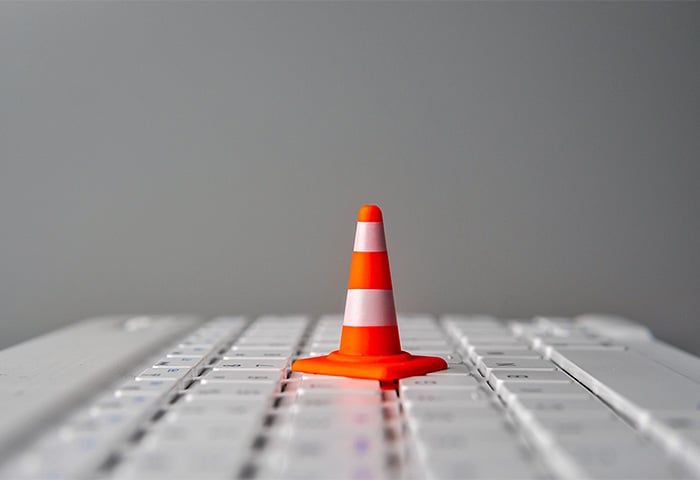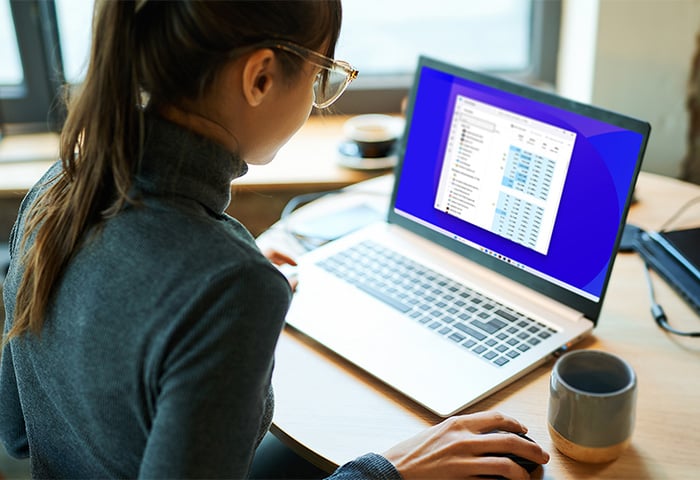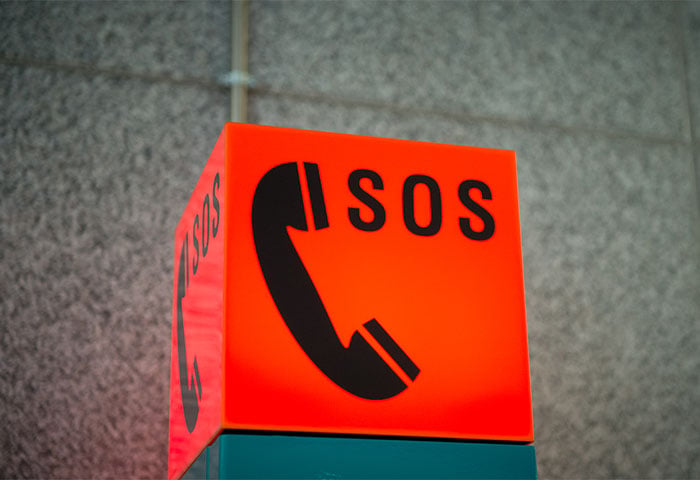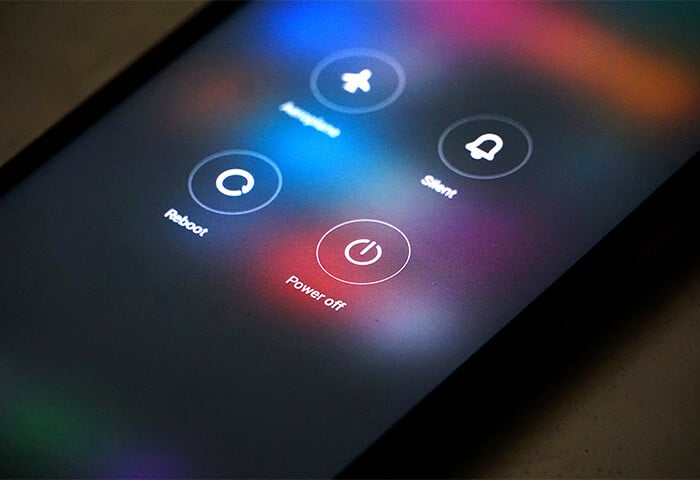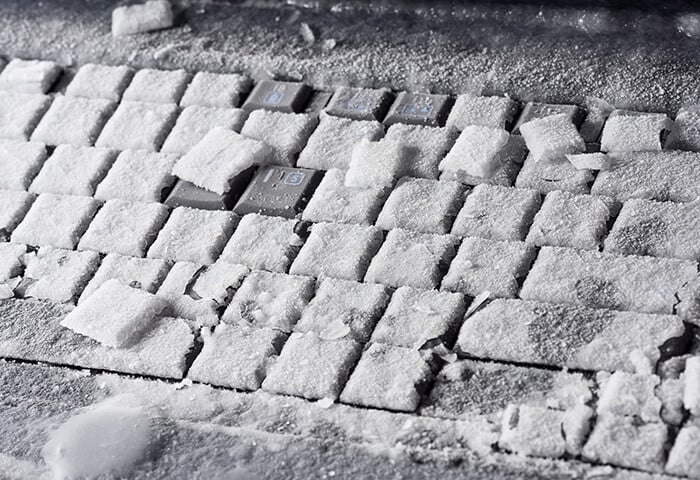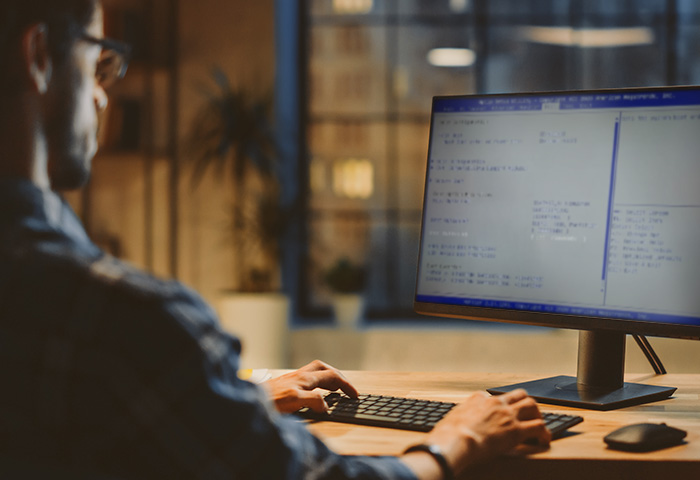What is the black screen of death?
The black screen of death is a critical system error that causes your computer screen to display all black. The system error forces your operating system to shut down because it can no longer safely function. The black screen of death can be caused by several factors, including hardware or software issues, or malware.
You can get a blank or black computer screen on startup, while updating software, or in the middle of device usage. Sometimes you can resolve a black screen on Windows 10 or 11 by rebooting your device. But in serious cases, you may need to perform a system restore or reinstall the operating system (OS).
 The black screen of death appearing on our own Windows 10 machine.
The black screen of death appearing on our own Windows 10 machine.
How to fix black screen on Windows 10
Here are some quick ways to fix a black screen on Windows 10:
-
Use the keyboard shortcut Windows key + P or Ctrl + Alt + Del to reset the screen’s graphics system. If the issue causing your Windows 10 black screen is a simple one, a keyboard shortcut can help solve it.
-
Hold down the power button for 10-15 seconds to do a hard reset on your laptop or PC and reboot your computer. If your computer won’t reboot and displays a black screen again, see the section below on fixing a black screen before login.
How to fix black screen on Windows 11
Similar to Windows 10, you can use a keyboard shortcut — Windows logo key + P or Ctrl + Alt + Del — to wake up your Windows 11 screen. Or, hold the power button for 10-15 seconds to reboot your device completely.
If these solutions don’t work, don’t worry: we’ll guide you through the necessary steps to diagnose and fix the issues causing the black screen of death, both before login and after.
Solutions for a black screen — before logging in
A black screen before your Windows login screen appears is usually easy to fix. You’ll just need to target the actual cause of your particular black screen issue.
Here are some ways to fix a Windows black screen before login:
1. Optimize your startup applications
If your PC or laptop displays a black screen on startup, try disabling some startup apps to optimize your boot. AVG TuneUp lets you turn off all non-essential applications and put them to sleep automatically. Its built-in Sleep Mode feature helps you get the most out of your RAM and CPU power so you have the resources you need at startup.
2. Check your cables and connections
If your otherwise fully-functioning Windows device suddenly displays a blank screen, check your computer cables connected to your monitor. There could be an issue with the connection or the actual cables.
Here’s how to check your cables and other important connections and peripherals:
Unplug and reconnect your video cables
Disconnect and reconnect all of your video cables — HDMI, DVI, DisplayPort, and VGA. Try blowing gently into the ports to clear any dust or other debris that might be interfering with the connection.
 Unplug and reconnect your cables and peripheral connections.
Unplug and reconnect your cables and peripheral connections.
Try a different cable
Constantly unplugging and plugging in cables causes them to wear out over time, and eventually, they break — especially if you use a laptop with an external monitor.
To check whether your cable is causing the black screen, try plugging in a different video cable that you know works, like the one from your TV. If you get an image instead of a blank screen with that cable connection, it’s time to get a new computer cable.
Try a different monitor
Your monitor display might be defective or set to the wrong source, which can also lead to a black screen. Try connecting to a different display if you have one. Or move from your monitor to your TV (or vice versa).
A blank screen on startup for a Windows 10 or 11 build might also be caused by a mismatch between your monitor and your display’s resolution.
For example, an optimized gaming PC might not work with a projector that can’t display the high resolution. If your Windows PC shows a “boot error” when connected to a projector, try hooking it up to a regular monitor. If the monitor displays images normally, your issue is likely due to a resolution requirement that your projector can’t handle.
3. Unplug all unnecessary accessories
External hard drives, USB connections, Wi-Fi antennas, VR headsets, and other accessories can cause issues during boot. If your computer screen is black on startup, unplug everything that’s not essential for your PC to work. Leave only your monitor, mouse, and keyboard plugged in, and restart your computer.
If you suspect it’s a hard drive issue, you can check for signs of hard drive failure and use CHKDSK commands to fix hard drive issues.
On a bigger desktop computer, try removing all unnecessary components, like sound cards and extra RAM (random access memory) sticks. If you still see nothing on your screen after startup, switch out the graphics card and upgrade your RAM completely.
4. Try a BIOS/UEFI reset and check the boot order
BIOS and UEFI are crucial programs that manage essential hardware configurations and ensure the proper launch of your operating system. BIOS is commonly used in older PCs, while UEFI runs on newer models. If you’re getting a black screen of death, try reverting to the default settings.
Here’s how to reset BIOS/UEFI:
-
Turn off your PC, then hit the power button to turn it back on.
-
Immediately during startup, you’ll get a prompt to hit a certain key to enter setup (usually F2 or the DEL key). Hit that key repeatedly.
Now, you can try two things:
Reset to default settings
Find an entry that says Load defaults (or Optimized defaults or something similar). Depending on your device build, BIOS/UEFI looks different. But the general wording of the entry should be similar. Selecting this option resets everything back to default settings.
 Resetting a Windows 10 computer to its default settings.
Resetting a Windows 10 computer to its default settings.
Make sure your PC boots from its hard disk
The BIOS/UEFI also controls how your PC starts up. Your PC could boot from a hard disk, a CD/DVD (rescue disk), a USB thumb drive (to install Windows), or even a floppy drive. In the Boot Priority (or First Boot Device) settings, ensure the hard disk option is selected.
 Setting the boot priority to hard drive on Windows 10.
Setting the boot priority to hard drive on Windows 10.
You can also check your BIOS/UEFI performance by running a CPU stress test. If your computer fails the test and causes the black screen of death, your BIOS/UEFI drivers might be outdated. You can easily update your drivers with one of the best free driver updaters on the market.
5. Launch a Windows repair
If your PC boots to a black screen and you still see nothing, try launching a Windows repair, which is a set of tools and diagnostic utilities built directly into the operation system.
Here’s how to launch the Windows Startup Automatic Repair screen:
-
Restart your PC several times. Doing this repeatedly will launch the Windows Startup Automatic Repair screen. Click Restart. If it doesn’t fix the black screen issue, repeat this step and select Advanced options.

-
Click System Restore.

-
Once System Restore opens, select a system restore point that’s a few days old, or from a period before you started having black screen issues.

-
Hit Next, then wait for Windows to restore all necessary files and return to working order. In some cases, you might need to reinstall an application or an update that you installed after the restore point and before you got the black screen on Windows.
If the Windows Automatic Repair doesn’t work, you need to create a bootable Windows 10 drive, plug it in, and use the disk-boot tip above to make sure your PC boots from the USB drive.
6. Boot into Safe Mode
Windows Safe Mode launches your PC with the minimum drivers and programs running, which may help you avoid a black screen at startup. Safe Mode means only Windows launches — eliminating any interference from unnecessary programs or drivers.
Here’s how to boot Windows into Safe Mode:
-
Follow the steps above to launch the Windows Repair tool.
-
This time, click Startup Settings. If you don’t see that option, click See more recovery options, then click Startup Settings.
-
Next, click Restart. After a few seconds, you’ll see the Startup Settings screen.

-
Press 5 on your keyboard to launch your computer in Safe Mode with Networking.

-
Once Windows has booted up, your desktop in Safe Mode should look something like this:

Now, you can start eliminating potential causes of the Windows 10 or 11 black screen of death. Try these two methods:
-
First, uninstall applications that could interfere with your boot, like graphics drivers, audio drivers, or network drivers.

-
Then, disable all startup items using the Task Manager: Right-click your taskbar, select Task Manager, then go to Startup. Turn off everything in this tab by right-clicking each item and selecting Disable.

Now, reboot your Windows system normally. If the black screen is gone and everything is working, perform the steps above in reverse order, re-enabling one task at a time. In other words, enable one item in Task Manager, reboot, and ensure everything works. Then, repeat the process with the next item on the list. This process will help you identify the program preventing your system from rebooting.
7. Roll back or update all drivers in Safe Mode
As mentioned above, a faulty device driver can cause an unbootable system. To fix this, uninstall any device drivers that could be a problem.
Here’s how to roll back or update drivers in Safe Mode:
-
Right-click Windows Start and select Device Manager.

-
Go to the problematic device driver (usually drivers like display adapters, network adapters, or sound, video, and game controllers). Double-click the entry, such as NVIDIA GeForce GTX 1650. Then, go to the Driver tab and select Roll Back Driver. Click Yes to confirm.

If that doesn’t help, updating your drivers might fix your Windows black screen problem. Check out our ultimate guide on finding and updating device drivers.
If you want to update your drivers immediately and keep them updated automatically, get AVG Driver Updater and run a free scan. AVG Driver Updater’s easy-to-use dashboard will help you identify and update your outdated or faulty drivers, fix lingering driver issues, and get your computer working optimally again.
Solutions for a black screen of death — after logging in
If you get a black screen after entering your password and logging in, you can still find the source of the issue using one of the solutions below.
Here’s how to fix a Windows black screen after login:
1. Disable all automatic applications
If you see a black screen after login on a Windows 10 or 11 device, something is affecting your operating system while it’s trying to load your desktop and icons. Usually, it’s an app that’s loading automatically.
Here’s how to disable all automatic apps:
-
Press Ctrl + Alt + Delete simultaneously and select Task Manager. If the black screen prevents you from getting to Task Manager, follow the steps above on how to boot into Safe Mode.
-
In Task Manager, go to Startup and disable every item. Reboot your computer and check if everything works normally.

Check Task Manager as part of regular PC maintenance. Disabling resource-draining apps at startup and using a PC cleaner tool are easy ways to speed up your PC’s boot time and help avoid the black screen of death altogether.
2. Start explorer.exe
The program explorer.exe (Windows Explorer) is responsible for loading your desktop and icons. If the program isn’t loading after login, then Windows Explorer is malfunctioning and all you’ll see is a black screen with a floating cursor or logo.
Here’s how start explorer.exe:
-
Press Ctrl + Alt + Delete simultaneously and select Task Manager (or hit Ctrl + Shift + Esc to launch it directly).
-
In Task Manager, click File > Run new task. Type explorer.exe and click OK.

Your desktop should now reappear.

Now that you got your desktop back, you’ll need to get Windows Explorer loading automatically at login. To do so, edit the Windows Registry — the heart of the Windows operating system. And before making any changes, create a backup of your PC or system restore point.
(Note: Only edit the Windows Registry if you know what you’re doing. You can also use a specialized registry cleaning tool to clean up and repair any broken registry items on your Windows PC.)
Here’s how to fix Windows Explorer launch via Windows Registry:
-
Hold down the Windows key and press R. In the Run box, type in regedit. Hit Enter.

-
Go to the following folder (also called keys): HKEY_LOCAL_MACHINE > SOFTWARE > Microsoft > Windows NT > CurrentVersion > Winlogon.
On the right side of the screen, double-click Shell. Check that the Value data section reads explorer.exe. If this field is empty or something else is there, enter explorer.exe.

If something else is written in the Value data section, it could be a virus, malware, or some other potentially unwanted program. To find out, Google the name of the program and do some research. If it’s a virus, learn how to get rid of a virus or malware on your computer. And if your search doesn’t turn up any info, run a virus scan or adware cleaner tool just in case.
A strong antivirus program like AVG AntiVirus FREE will scan your machine from top to bottom to find any malicious code. And it will delete the malware and set up defenses to help detect and block any future signs of trouble.
3. Install a new graphics driver
If you get frequent (and seemingly random) Windows black screen issues, your graphics driver could be the reason. Make sure to update all AMD, Intel, and NVIDIA drivers regularly so that your graphics card works properly. Check out our detailed instructions on how to update your graphics drivers and our guide to monitoring GPU performance.
4. Switch between screens
If your PC is connected to multiple monitors or even a VR headset (which Windows identifies as a monitor), you can accidentally switch your output to a screen that’s off. When you see a blank screen, hold down the Windows key on your keyboard and press P. This shows your display mode options, and allows you to switch.

Why does my screen keep going black?
Your screen keeps going black due to a critical error in your computer's operating system, like a faulty device driver, a hardware defect, a Windows software glitch, or even malware. While usually fixable, finding the root cause of the black screen isn’t always easy.
Here are some common causes of a Windows 10 or 11 black screen:
-
A Windows update gone wrong
-
A faulty startup application
-
Outdated or faulty drivers
-
Connection issues between your PC and monitor
-
Software or hardware defects
-
Problems with your graphics card
-
Loose cables connected to your PC or laptop
If you see the full black screen before login, it’s probably due to a malfunctioning device driver or a hardware issue. If the blank screen happens after login, there’s likely something wrong with Windows, like a buggy Windows 10 update or a problem with an installed app.
Performance users
You may also run into black screen issues when you’re trying to get the most out of your system for gaming or resource-intensive tasks, like video editing. Overclocking helps optimize PC performance, but it could lead to overheating and GPU issues — possibly leading to the black screen of death.
If you want to boost PC performance while avoiding a black screen, learn how to overclock CPUs safely — and always check GPU temperatures to maintain safe performance. And while you’re at it, learn how to fix that loud computer fan for optimal performance all around.
Get out of the dark with a PC optimization app
Fixing a black screen on Windows is relatively simple, but maintaining a properly functioning device is key to avoiding future issues. Use AVG TuneUp to keep your WIndows device updated, optimized, and running smoothly.
AVG TuneUp’s Automatic Maintenance feature tunes your device regularly, while its Sleep Mode feature disables unnecessary applications, ensuring you have the power you need for the apps and programs you’re using. Plus, the built-in Software Uninstaller gets rid of apps that could render your system unbootable. Step into the light: try AVG TuneUp today and say goodbye to Windows black screen issues.
FAQs
What causes the black screen of death?
A blank or black screen on Windows is usually caused by improperly installed, damaged, or outdated hardware; incompatible software; or poorly installed drivers or updates.
Is the black screen of death common?
The black screen is the most commonly seen error on a computer. The operating system usually displays it after encountering a critical system error.
What does the screen of death look like?
The screen of death comes in different colors, depending on the OS you’re running. The screen can be blue (Blue Screen of Death or BSoD), black, or red.
What is the most fatal screen of death?
The Black Screen of Death is usually considered the most fatal, especially when no error is displayed on the screen. It can be due to an error in a Windows update or hardware or software issues.
Does a black screen mean a virus?
A black screen doesn’t usually mean you have a computer virus. It is an issue resulting from a problem with hardware or software updates or installations.

 The black screen of death appearing on our own Windows 10 machine.
The black screen of death appearing on our own Windows 10 machine. Unplug and reconnect your cables and peripheral connections.
Unplug and reconnect your cables and peripheral connections. Resetting a Windows 10 computer to its default settings.
Resetting a Windows 10 computer to its default settings. Setting the boot priority to hard drive on Windows 10.
Setting the boot priority to hard drive on Windows 10.















